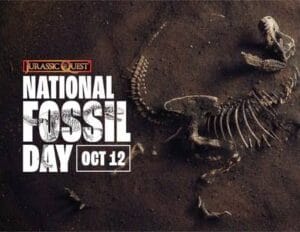National Fossil Day – October 12, 2022, history, significance
Fossils aren’t just interesting and fun to look at — they’re also proof of the existence of once-living things (like dinosaurs, animals, plants and even DNA remnants). Through these fossils we’re able to learn a lot about life from billions of years ago. We can even take a look at animals and life-forms that are no longer on the planet!
These fossils (and the education around them) deserve to be preserved and explored. That’s why we celebrate National Fossil Day annually on the Wednesday of the second full week in October, with this year’s celebration being held on October 12. Show some appreciation for these incredible “time capsules” and the paleontologists who excavate them.
History of National Fossil Day

Founded in the United States in 2010 by a senior paleontologist from the National Parks Service, Vincent L. Stannuci, National Fossil Day offers a delightful opportunity for humans of all ages to celebrate their geologic history.
Originating as a day focused on fossils that ran during Earth Science Week, this day has evolved on its own and now has partners in all 50 of the US states. The day continues to be supported by the National Parks Service, hosting many events and programs through its partnerships with the Geological Society of America, Paleontological Society, Smithsonian, the American Museum of National History and many other partners.
NATIONAL FOSSIL DAY TIMELINE
1840s – 1850s
Researchers discovered the Neanderthal
Ancient human fossils were unearthed for the first time, proving the existence of the Neanderthal.
1902
Proof of T-Rex
Researchers uncovered the first Tyrannosaurus Rex remains.
1974
Lucy was born
Scientists found fossils of a 3.5 million-year-old female hominin (an extinct human species) and named her “Lucy.”
HOW TO OBSERVE NATIONAL FOSSIL DAY
Hug a paleontologist
Paleontologists are pretty incredible people. They go through lots of schooling and training to be able to study the fossils of all kinds of organisms. It’s because of them that we know a lot about the last few billion years of our planet’s history. Show your appreciation by giving them a hug, and asking them to tell you more!
Check out local events
Every year, the National Park Service partners with various organizations, universities, museums and more to celebrate National Fossil Day. Through field trips, classroom instruction and outdoor activities, they’re spreading awareness about this important holiday.
Visit Your Nearest National Park
Many national parks are passionate about introducing future generations to the science behind fossils and paleontology. These may include anything from scavenger hunts, to multi-day ranger-led activities. Visit your nearest national park and discover all there is to know about this fascinating science!
4 FUN FOSSIL FACTS
They’re insanely valuable
The highest amount ever paid for a dinosaur fossil was $8.3 million (they named it “Sue”).
They can be enormous
The largest intact fossil ever discovered was a whopping 4 square miles!
Anything can be fossilized
The smallest fossil on record was just 2/10 of a millimeter (it was of a 50-million-year-old parasite).
They’re ridiculously old
Next time you’re feeling old, just remember some fossils date back to 4.1 billion years.
WHY NATIONAL FOSSIL DAY IS IMPORTANT
We can learn about our planet
A fossil is evidence of past life that’s been preserved in rock. This helps us discover all kinds of shells, plants, animals, and more that existed long before our time. This information helps us understand what was happening during each part of our planet’s history.
We can understand the progression of time
By looking at fossils, researchers have been able to understand how and when organisms appeared and disappeared throughout the passage of time. This is how they’ve been able to divide up the events in our planet’s history into different periods.
We can look toward the future
Each fossil tells a story of the organism it encapsulates, and the details of when it was on the earth. By examining fossils, we can use these stories to help inform us about the future, and how environmental factors (as well as man-made ones) will help influence our planet for future generations.



